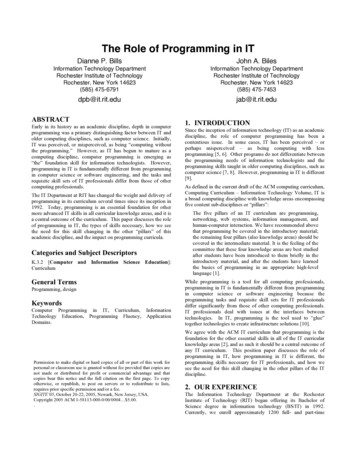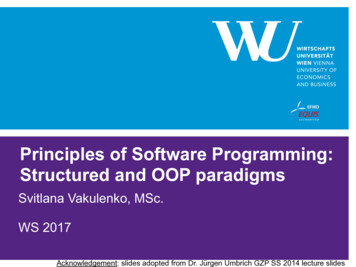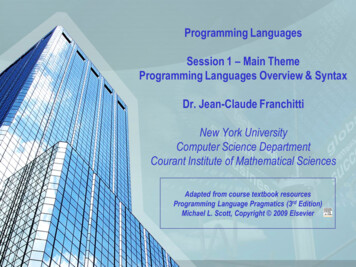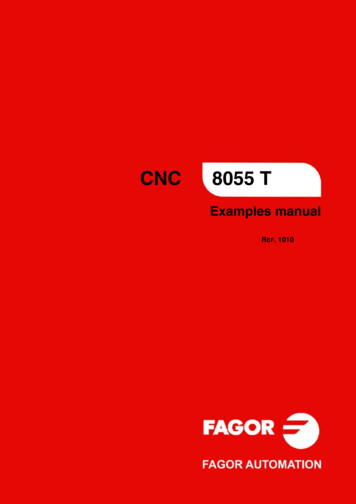
Transcription
The Role of Programming in ITDianne P. BillsJohn A. BilesInformation Technology DepartmentRochester Institute of TechnologyRochester, New York 14623(585) 475-6791Information Technology DepartmentRochester Institute of TechnologyRochester, New York 14623(585) 475-7453dpb@it.rit.edujab@it.rit.eduABSTRACTEarly in its history as an academic discipline, depth in computerprogramming was a primary distinguishing factor between IT andolder computing disciplines, such as computer science. Initially,IT was perceived, or misperceived, as being “computing withoutthe programming.” However, as IT has begun to mature as acomputing discipline, computer programming is emerging as“the” foundation skill for information technologists. However,programming in IT is fundamentally different from programmingin computer science or software engineering, and the tasks andrequisite skill sets of IT professionals differ from those of othercomputing professionals.The IT Department at RIT has changed the weight and delivery ofprogramming in its curriculum several times since its inception in1992. Today, programming is an essential foundation for othermore advanced IT skills in all curricular knowledge areas, and it isa central outcome of the curriculum. This paper discusses the roleof programming in IT, the types of skills necessary, how we seethe need for this skill changing in the other “pillars” of thisacademic discipline, and the impact on programming curricula.Categories and Subject DescriptorsK.3.2 [Computer and Information Science Education]:CurriculumGeneral TermsProgramming, designKeywordsComputer Programming in IT, Curriculum, InformationTechnology Education, Programming Fluency, ApplicationDomains.Permission to make digital or hard copies of all or part of this work forpersonal or classroom use is granted without fee provided that copies arenot made or distributed for profit or commercial advantage and thatcopies bear this notice and the full citation on the first page. To copyotherwise, or republish, to post on servers or to redistribute to lists,requires prior specific permission and/or a fee.SIGITE’05, October 20-22, 2005, Newark, New Jersey, USA.Copyright 2005 ACM 1-58113-000-0/00/0004 5.00.1. INTRODUCTIONSince the inception of information technology (IT) as an academicdiscipline, the role of computer programming has been acontentious issue. In some cases, IT has been perceived – orperhaps misperceived – as being computing with lessprogramming [5, 6]. Other programs do not differentiate betweenthe programming needs of information technologists and theprogramming skills taught in older computing disciplines, such ascomputer science [7, 8]. However, programming in IT is different[9].As defined in the current draft of the ACM computing curriculum,Computing Curriculum – Information Technology Volume, IT isa broad computing discipline with knowledge areas encompassingfive content sub-disciplines or “pillars”:The five pillars of an IT curriculum are programming,networking, web systems, information management, andhuman-computer interaction. We have recommended abovethat programming be covered in the introductory material;the remaining four pillars (also knowledge areas) should becovered in the intermediate material. It is the feeling of thecommittee that these four knowledge areas are best studiedafter students have been introduced to them briefly in theintroductory material, and after the students have learnedthe basics of programming in an appropriate high-levellanguage [1].While programming is a tool for all computing professionals,programming in IT is fundamentally different from programmingin computer science or software engineering because theprogramming tasks and requisite skill sets for IT professionalsdiffer significantly from those of other computing professionals.IT professionals deal with issues at the interfaces betweentechnologies. In IT, programming is the tool used to “glue”together technologies to create infrastructure solutions [10].We agree with the ACM IT curriculum that programming is thefoundation for the other essential skills in all of the IT curricularknowledge areas [2], and as such it should be a central outcome ofany IT curriculum. This position paper discusses the role ofprogramming in IT, how programming in IT is different, theprogramming skills necessary for IT professionals, and how wesee the need for this skill changing in the other pillars of the ITdiscipline.2. OUR EXPERIENCEThe Information Technology Department at the RochesterInstitute of Technology (RIT) began offering its Bachelor ofScience degree in information technology (BS/IT) in 1992.Currently, we enroll approximately 1200 full- and part-time
undergraduate students and admit over 200 new freshmen eachyear.Since the beginning, computer programming has consistently beena key component of our IT curriculum. However, our perceptionof the role of programming and the skills needed by ITprofessionals has changed as the IT discipline has matured. Wecurrently see programming as “the” fundamental technical skillfor information technologists, and we believe that the importanceof strong programming skills for information technologists willincrease in the future. To understand how we have arrived at thisconclusion, some discussion of our experience in teachingprogramming is necessary. Table 1 shows a chronology of theprogramming experiences we have offered in our baccalaureate ITprogram since the start of our degree.Table 1. Programming 8-91999-01StudentYearFirstFallWinterSpringC C First-SecondFirstSecondFirstFirstFirstC C C VBVBC ToolBook2HyperCard 3C HyperCardVBC VBVBC C 2001-05-When we deployed our first IT curriculum in 1992, we taughtC in our freshmen programming sequence. We offered oneyear of C programming in three (3) courses: an introductoryprogramming course, an introduction to OOP concepts, and anintroduction to GUI interfaces and events. In 1993 we beganoffering a “pre-programming course” to provide a fundamentalunderstanding of events and event handling, first in ToolBook,then in HyperCard, and finally in Visual Basic. By 1996 we hadeliminated event-driven programming in C in favor of VisualBasic because freshmen had understandable difficulty with eventdriven GUI concepts in C .In 1998, we evaluated Java as a possible foundation language forteaching introductory programming but found it too unstable. Wefelt at that time that the Java programming environment wasinappropriate for novice programmers who could not tell thedifference between their own mistakes and bugs in the compiler.So we settled on Visual Basic as our foundation language andeliminated C from our core curriculum.1RIT’s academic calendar is based on four three-month quartersper calendar year.2Platte Canyon Multimedia Software Corporation,http://www.plattecanyon.com/3Apple Corporation, www.apple.com4Macromedia Corporation, http://www.macromedia.com/Beginning in 1998, then, we offered a two-course Visual Basic(VB) freshman programming sequence for the next three years.Although the VB programming interface is very good forillustrating objects and events, and is a fine “glue” environment,we found that it was a poor pedagogical tool for noviceprogrammers because they had difficulty seeing the “whole”program. Having the code distributed across multiple objects tooearly in the learning process tended to confuse some students. Wefound that, on average, retention of programming concepts wasnot as strong as we felt necessary, and we found that students alsohad problems transferring their knowledge to later courses thatused programming languages without GUI interfaces.In addition, we became concerned that six months ofprogramming was not a sufficient foundation for the programmingskills necessary for our upper-level IT curriculum. Although weadded a Director-based authoring and animation course to the corein 1999 and had already added programming assignments to theother courses in the BS/IT core to help students retain theirprogramming skills, we were still not seeing the overall level ofproficiency that we wanted.So we turned our attention back to Java in 2001 and decided thatit had stabilized sufficiently for our freshmen. We currently teachour foundation programming sequence as three Java courses: afirst course in introductory programming concepts, a secondcourse in OOP concepts with I/O, error handling and the basicGUI interface classes, and a third course on advanced GUIconcepts, data structures with threads and sockets, utilities,reusability, and software project management concepts. We teachthe sequence in specially-designed classrooms that support activelearning. As previously reported [3][4], this sequence has beenvery successful. Student feedback has been positive; retentionthrough the first year programming sequence has increased; andthe faculty is more satisfied with students’ demonstrated skills indownstream courses.We feel that an understanding of software objects and the firing ofand response to events within and between software/hardwaresystems is critical for IT professionals. At its most basic, theability to program provides the capability of interpreting eventsand “thinking like the machine” that is so critical for successfulproblem solving within the computing domain. This abilityenables students to see the synergy between the IT knowledgeareas that is necessary for successful IT professionals.3. OUR CURRENT PERSPECTIVEIT is a diverse computing discipline, with a wide variety ofrapidly emerging sub-disciplines. This makes it difficult toidentify the common core competencies in programming for all ITprofessionals. However, we feel that there are identifiableexpected outcomes for programming that span the IT spectrum.These common outcomes not only help sharpen the focus of ITprogramming curricula; they also help define IT as a unifieddiscipline.IT programming outcomes differ from the expected programmingoutcomes in Computer Science (CS) and Software Engineering(SE). Some of these differences are fundamental, and some aremore subtle, but they help delineate IT curricula from CS/SEcurricula. RIT is currently the only institute of higher education tohave professionally accredited Bachelors programs in InformationTechnology, Computer Science, Software Engineering andComputer Engineering (CE). Consequently, we feel we have aunique perspective on the differences between these computing
disciplines. While there are differences in expected outcomesamong CS, SE and CE, they are less pronounced than thosebetween any of them and IT. For this paper, then, we’ll lump CS,SE and CE together and call the aggregate CS/SE, in deference tothe fact that CS, SE and CE students at RIT all take the same fivecourse programming sequence from the CS and SE departments.IT students take a different programming sequence offered by theIT department, which reflects our beliefs that IT programmingskills differ fundamentally from CS, and that IT students are notwell served by a “standard” CS programming sequence.So what is programming in IT, and how does it differ fromprogramming in CS/SE? We’ll answer these two questionsconcurrently, since it is difficult to describe what characterizes ITprogramming without contrasting it with the well-knownbenchmark of CS/SE programming.Probably the biggest distinction is that IT professionals don’tbuild large systems from scratch. An essential outcome in CS/SEis the ability to build large software systems from scratch in ateam setting, in other words, classic software engineering. ITprofessionals, on the other hand, are not software engineers. Theymay build large systems, but not from scratch.This distinction arises from one of the fundamental differencesbetween IT and CS/SE/CE as academic disciplines – CS, SE andCE focus on creating new technology, while IT focuses onmaking effective use of existing technology [10]. In theprogramming arena this means that CS/SE must be able to buildlarge systems from scratch; that’s what it means to “create” newsoftware technology. IT, on the other hand, tends to build systemsfrom existing components. IT systems can be very large, to besure, but they are built by integrating existing functionality thathas been identified as useful to a targeted user community.Consider, as an example IT application, a Web-based, multi-usergame developed by a team of four students for a Web-databaseintegration course offered at RIT in the spring, 2005 quarter. Thegaming domain is perfect for illustrating the IT applicationdevelopment process because today’s multi-user games rest firmlyon all five of the IT pillars and, therefore, are essentially amicrocosm of the IT discipline. Game design and development isalso one of our most popular IT concentration areas and is thecareer most frequently asked about among our entering students.Our example application is a Web-based, multi-user, exploratorygame, where users wander through a virtual space of connectingrooms and interact both with objects in the rooms and with otherplayers that they encounter. The interactions with other playerstake the form of mini-games, with each room supporting adifferent mini-game. The interactions in this game lead to twodifferent kinds of data communication – asynchronous, forloading room information when a player enters a new room, andsynchronous, for interacting with other players and with objectswithin a room. A database (MySQL) stores everything used inplaying the game: room information and methods, characterinformation (including avatars), user account information, images,sounds, graphics, and animations. The client side is implementedin Flash and communicates with the database via a PHP-basedmiddle layer that accommodates interface inconsistencies betweenFlash and MySQL and filters information for appropriate use bydestination processes. In summary, this is a classic three-tierapplication with real-time interactive multimedia.There are significant design issues in this application. Forexample, PHP can pull, but it can’t push, so the client processmust poll the server periodically in order to reflect changes in theroom. Polling too frequently can swamp the server, whichdegrades the real-time illusion. Polling too infrequently alsodegrades the experience. Another design issue is the choice ofwhen to use time-based animation (the movie metaphor) andwhen to use code-driven animation (sprites moving underprogram control). Each method offers different advantages anddisadvantages, and each method raises different integration issues.In short, applications like this, which are typical in the IT world,offer significant levels of complexity and demand careful designin order to successfully integrate disparate components.It is tempting to say that CS does programming in the large, whileIT does programming in the small [11]. It is true that most ITapplications are built by individuals or small groups and that theseapplications are often systems of scripts that glue together existingcomponents and provide a usable interface to the integratedfunctionality of those components. However, these applicationscan be quite large and complex, as the previous exampleillustrates.The distinction we would make is that CS focuses on designingarchitectures where the components are mutable, and IT focuseson building architectures that both accommodate and takeadvantage of existing components. In other words, CS/SE gets todesign the components themselves and the interfaces amongcomponents, while IT has to work with the interfaces that othersdevelop. The issue here, obviously, is reuse, something that goodsoftware engineering is supposed to facilitate. However, mostsoftware engineers will gladly build a new component if theexisting component doesn’t fit the architecture. In IT, the neededskill is to make the component fit, often by building a filter ormiddle layer to integrate disparate components. The outcome inCS/SE is to design for reuse; the outcome in IT is to design byreuse.Some in the CS/SE community see the IT aversion to buildingthings from scratch as a lack of ability to deal with complexity oras just laziness [16]. This criticism is incorrect. IT professionalscome at an application from the user’s perspective rather than thecomputer’s perspective, and their priority is to identify and meetuser needs. This requires a more flexible approach to applicationdevelopment than the traditional waterfall model allows anddemands that maximum use be made of existing functionality inorder to be productive. To be fair, the increasing popularity ofagile computing methodologies [14] in the SE community is agood response to this issue.4. PROGRAMMING IN THE PILLARSHistorically when a new IT technology has emerged, directprogramming has initially tended to play little or no role.However as a technology advances and its functionality isenhanced, it tends to become more powerful and then requiresprogramming. Web pages are a classic example. Early Webpages were built from static HTML scripts. Web pages today aredynamic, with programming functionality on the client side, onthe server side, and for connectivity with backend databases.We assert that as technology continues to advance, programmingwill become an increasingly important part of the responsibilitiesof the IT professional, regardless of specialty area. So we lookedat where programming exists within our curriculum and talkedwith colleagues from each of the pillar areas to get theirperspectives on how computer programming is and will be used
within their areas. Table 2 shows the occurrence of programmingin RIT’s current upper-level, or post-core, BS/IT curriculum.at the transaction level. For these interfaces, writing an SQLstatement is not sufficient.Table 2. Programming Weight in BS/IT Post-CoreWhile SQL alone may suffice for simple reporting needs, ITdatabase professionals need to be able to handle data transfer,conversion, and cleansing as well as changes to the design of datasystems. This means using programmatic interfaces – typically acombination of traditional and DBMS programming languages aswell as scripting languages, such as Perl, which are useful for adhoc data extraction. The interpreted nature of scripting languagesmakes them perfect for “quick and dirty” data manipulation tasks.However, in situations where the “right” component for a task isnot readily available, database professionals need the ability tocode.BS/IT PillarProgramming(including games)DatabaseNetworkingWeb TechnologiesHCI# CoursesWeight7100.0%41911650.0%26.3%72.7%33.0%IT students at RIT complete two three-course concentrationschosen from 12 that are currently available. Some of theseconcentrations fit neatly into one of the five IT pillars. Forexample, Network Administration, Wireless Networking, andSystem Administration all fit into the Networking pillar. GameDesign and Development, on the other hand, fits well in bothprogramming and Web technologies, with a heavy dose of HCIand definite needs from networking and database. As we havenoted before, it is the synergy of among the pillars that defines IT[13].The “# Courses” column in Table 2 reflects a somewhat arbitraryassignment of each advanced course to one of the five pillars. Forexample, our games courses were assigned to the programmingpillar. The “Weight” column reflects the percentage of post-corecourses in that pillar in which programming is a primary activity.This is usually manifested in one or more projects that requiresignificant programming, often a “final” project. We’ll turn nowto the five IT pillars and briefly discuss the kinds of programmingthat are typical in each.4.1 ProgrammingIt’s not surprising that all of the advanced courses in theprogramming pillar require programming. Our switch from VB toJava as the language used in our introductory courses four yearsago has led to a corresponding migration from .NET to Java-baseddevelopment in our advanced programming courses in the last twoyears. The advanced IT programming courses focus on advancedapplication development spanning multiple languages, workingwith component models and security models, and distributedprogramming using various APIs. The specific languages used inthese courses are only tools, but we’ve gotten greater tractionfrom Java as the base language.We grouped the three-course gaming concentration in this pillarbecause the focus in those courses is on “heavyweight” gamesdeveloped in C and running as standalone applications, thecurrent gaming industry standard. Web-based, “lightweight”games tend to come out of our interactive media group, and lineup best with the Web technologies pillar. The term lightweight,however, can be misleading, as our multi-user, Web-based gameexample described above illustrates.4.2 DatabaseProgramming is important with databases because the types ofinterfaces through which we currently access information,client/server and the web, are not expected to change for theforeseeable future. These applications employ connectivitythrough JDBC or .Net technology and require data manipulationEven if a database professional should never needs to writeprograms, he or she still must be able to interact withprogramming professionals during software development projectsand help formulate the solution to problems. This fact alonenecessitates a solid understanding of computer programmingprinciples (private conversation with Prof. Kevin Bierre,Information Technology Department, RIT, 6/21/05).4.3 NetworkingIT networking and system administration professionals need solidprogramming skills to support their understanding of networkprotocols at the transport layer. Abstract manipulation skills areimportant here because they must be able to operationalizealgorithms on the TCP/IP stack and manipulate system tablesalgorithmically.In the future, networking appliances will incorporate more directadministrator-programming capabilities.Currently networkhardware is primarily programmed by the manufacturer, often atthe hardware level. However, in the near future, we expect thesedevices to be directly programmable by the networkadministrator. User-configurable network processors will betunable so that networking functions, such as routing, can beadjusted to special purposes and security needs. Plus, we expectnetworking and system administration functionality to be moreintegrated in future protocols. The ability to develop customizedsoftware solutions will be beneficial because since they aredirectly modifiable by the end user, sites will be able to deploytheir own protocols.Programming within this pillar is different from computer scienceprogramming in its depth. However, network and systemadministrators must be willing, capable, and unafraid to program(private conversation with Prof. Pete Lutz, InformationTechnology Department, 6/13/05).4.4 Web TechnologiesIn the early days of the WWW, it was sufficient to build staticWeb pages that displayed content as text and images. Interactivitywas limited to following hyperlinks to other pages, which was,and still is, highly useful, but requires no real programmingprowess. Today, Web sites, especially those that people actuallypay to have built, are dynamic, interactive, media-rich, and highlyadaptable. In other words, they actually do things, which requiresprogramming.The game example described above is a typical Web-basedapplication. Web applications are increasingly the preferreddeployment choice in many situations because platform,distribution and maintenance issues often can be dealt with more
easily. As is true in the other pillars, scripting largely replacestraditional programming as the primary activity, and the trend istoward more distributed applications and meta-approaches likeXML (private conversation with Prof. Chris Egert, InformationTechnology Department, June 22, 2005).4.5 Human-Computer InteractionIn the IT HCI pillar, programming once again takes a pivotal role,specifically in rapid prototyping activities that underlie theusability engineering lifecycle [12].This approach todevelopment focuses on building a useful and usable interfacefirst, using a spiral process of prototyping and usability testinguntil the user community buys into the prototype interface. Thisprocess helps identify and define functionality by giving users aclearer view of what the system will do, and more importantly,what it can do. Once the interface is solid, it’s time to identify anddefine the functionality required in the system. In a sense, thisdevelopment method is the opposite of the classic waterfallmodel. Instead of identifying functionality first and building theuser interface last, it uses the development of the interface as atool to identify needed functionality.5. THE MYTH OF THE COMMON CORESo what’s wrong with the typical CS/SE programming sequencefor IT students? One might argue that implementing the classicdata structures and algorithms from scratch and building entirelarge systems from the ground up (or the top down, as the casemay be) is a good preparation for any computing professional. Ifyou can build a huge system from scratch, then you surely canbuild a smaller system from components, or as the song says, “Ifyou can make it there, you can make it anywhere.”There are two questions that need to be answered, however. First,is the standard CS programming sequence necessary in order toprepare IT students for the kinds of programming tasks they needto perform? Second, if it is not necessary, is it at least sufficientfor preparing IT students. Our answer to both questions is “No.”It is necessary for IT students to be able to use stacks, queues,lists, trees, graphs and other data structures appropriately, but it isnot necessary that they implement them from scratch. Forexample, a software engineer working for Oracle needs to worryabout implementing external data structures like B-Trees in orderto make the Oracle engine efficient, but an Oracle applicationdeveloper doesn’t need to know how the tables they define aremapped to the disk. Similarly, the folks at Macromedia whodesign and implement the scripting environment in Flash need toknow something about designing language syntax and semantics,which they would have picked up writing a compiler in their CScurriculum, but the application developer who uses Flash to builda client agent in a multi-tier system need not know how the parserworks. In other words, it is not necessary to know how theunderlying technology was built in order to use it effectively,provided the underlying technology was built well.So if the standard CS programming sequence is not necessary forIT students, is it at least sufficient? After all, many, if not most,computing students begin their college careers not knowing thedifferences between the various computing disciplines, and IT, asthe newest, is often the biggest mystery. Wouldn’t it beadvantageous to give new students time to decide whether theywant to pursue IT, CS, SE, CE or even Information Systems byhaving all computing students take the same introductorysequence? Even though the standard CS isn’t an ideal fit for IT,isn’t it close enough?There are two reasons why the standard CS programmingsequence is not adequate for IT students. First, the expectedoutcomes from the CS sequence are not the outcomes expected ofIT students, as we’ve hopefully made clear. At RIT the first CSprogramming course and the first IT programming course havesimilar outcomes, using the standard data types and controlstructures, and introducing objects. In the second course, the twocourse sequences begin to diverge. CS presents object-orienteddevelopment by implementing classic data structures andalgorithms, while IT presents object-oriented development aimingtoward GUI development and component integration.In its third and last programming core course, IT focuses onthreads and synchronization, inter-process communication withsockets, and building moderate sized applications using availablecomponents. From this point on, programming in IT becomespillar-specific. In the third CS programming course, studentsbuild moderate-sized systems from scratch to prepare for the largesystems with external data structures they will build in the fourthCS course and to prepare them for the introduction to softwareengineering, which is the fifth course. CS, SE and CE students atRIT are expected to complete this five-quarter sequence by themiddle of the sophomore year. Thus, the expected outcomes fromthese two programming sequences are very different.The second reason why the CS/SE sequence is not sufficient forIT students is that it mandates a build-it-from-scratch mentalityamong students. Clearly both IT and CS/SE students must be ableto write a complete program from scratch. However, the firstinstinct of the IT professional should be to write a script tointegrate existing components rather than to write newcomponents. The nature of user-centered design is that the designmust change fundamentally during the development process tomeet the shifting needs of users. The spiral development processbriefly described in section 4.5 requires rapid prototyping;building components from scratch is simply not appropriate unlessand until useful functionality is identified that does not alreadyexist.Finally, there are the cultural differences between IT and CS/SE.Most who have taught programming for any length of time willagree that programming seems to be an unnatural act for moststudents, if not for most human beings.Retention inprogramming sequences is notoriously low, with a resulting lowretention of students in CS majors. This is a significant problemin meeting the needs of society for competent professionals acrossall the computing disciplines [15].For good or bad, the programming sequence in many CSprograms is seen as a mechanism for weeding out weak students.O
The Role of Programming in IT Dianne P. Bills Information Technology Department Rochester Institute of Technology Rochester, New York 14623 (585) 475-6791 dpb@it.rit.edu . u m an- c op t eri .W vdb th ap og m inb ecv du y l; the remaining four pillars (also knowledge areas) should be covered in the intermediate material. It is the feeling of the











